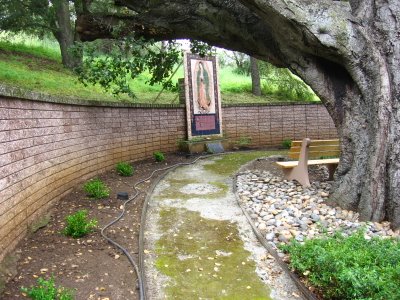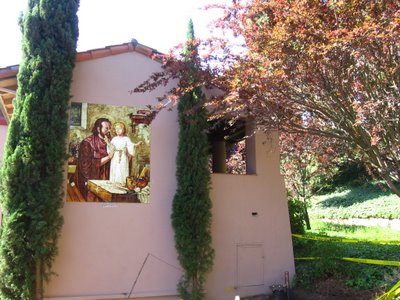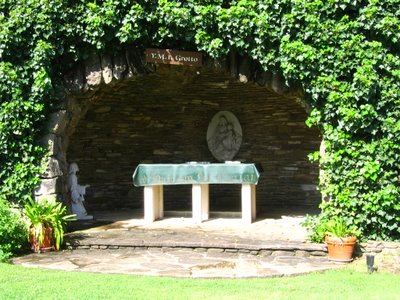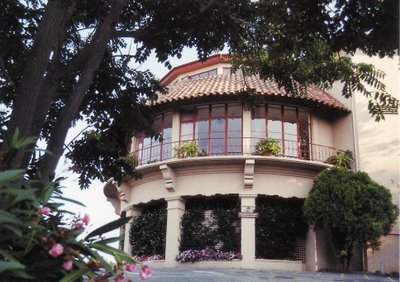El Retiro San Iñigo Ride
Prologue
This will be a strange write up. It is a bike ride, and yet it is not. It's more of a pilgrimage of sorts, a trip down memory lane; and yet it is a journey, a journey of renewal.
'Decided to ride to El Retiro San Iñigo today. Covering 35 acres and located in the hills above Los Altos, El Retiro San Iñigo is a Catholic Retreat Center administered by the Jesuit Order.
 Map of today's ride. 652 track points (blue diamonds) laid by the GPS unit.
Map of today's ride. 652 track points (blue diamonds) laid by the GPS unit. TOPO!'s elevation profile.
TOPO!'s elevation profile. A stone pillar with a brass plaque marks the entrance to the Jesuit Retreat Center.
A stone pillar with a brass plaque marks the entrance to the Jesuit Retreat Center. Looking at the Santa Cruz Mountain Range. Skyline Boulevard runs on its ridge. I was somewhere up there on a previous ride.
Looking at the Santa Cruz Mountain Range. Skyline Boulevard runs on its ridge. I was somewhere up there on a previous ride. A path I walked a long time ago.
A path I walked a long time ago. And one that I remember well. It was cold. It was wet. In the depths of late fall.
And one that I remember well. It was cold. It was wet. In the depths of late fall. Our Lady of Guatemala.
Our Lady of Guatemala. Closer.
Closer. Donated by the SFPD.
Donated by the SFPD. Flowers in bloom.
Flowers in bloom. It is quiet.
It is quiet. You can hear the wind between the crunch of oak leaves under your feet.
You can hear the wind between the crunch of oak leaves under your feet. Plenty of solitude for contemplation...
Plenty of solitude for contemplation...
 and meditation.
and meditation. The Agony in the Garden.
The Agony in the Garden.

Via Crucis. Figures are cast in bronze. In particular, the detail of the rope and bandages is remarkable.
 I
I II
II III
III IV
IV V
V VI
VI VII
VII VIII
VIII IX
IX X
X XI
XI XII
XII XIII
XIII XIV
XIV On top of the hill: St. Robert's Hall.
On top of the hill: St. Robert's Hall. When you search for me, you will find me;(Jeremiah 29:13)
when you search wholeheartedly for me,
I shall let you find me.
On the 12th of November 2000, I returned to the Roman Catholic Church, and had my first Eucharist here, with Father Peter Filice (now the superior of the Jesuit community at Loyola High), Father Luis F. Calero, Father Harris, and Sister Ingrid Honoré-Lallande. This place is very special, very sacred to me.
 St. Joseph's Hall, living quarters for retreatants. The rooms are austere. A bible, a crucifix, a bed, a writing desk, and a bathroom. That's it.
St. Joseph's Hall, living quarters for retreatants. The rooms are austere. A bible, a crucifix, a bed, a writing desk, and a bathroom. That's it.  Close up of the mural.
Close up of the mural. I lived in the room on the far right for 3 days in November 2000. It was a silent retreat. That is, apart from a daily 30-minute spiritual counseling session with your priest, you do not talk to anyone except God. You do not bring your cell phone here. You leave it in the car. No radio. No CD player. No GameBoy. There is you (there is silence) and there is God.
I lived in the room on the far right for 3 days in November 2000. It was a silent retreat. That is, apart from a daily 30-minute spiritual counseling session with your priest, you do not talk to anyone except God. You do not bring your cell phone here. You leave it in the car. No radio. No CD player. No GameBoy. There is you (there is silence) and there is God. Each day at 7 AM, before going for breakfast, I would walk up this slope to St. Robert's Hall in the cold for morning prayer.
Each day at 7 AM, before going for breakfast, I would walk up this slope to St. Robert's Hall in the cold for morning prayer. Dining room.
Dining room. Rossi Chapel.
Rossi Chapel. Interior of Rossi Chapel.
Interior of Rossi Chapel. Saint Ignatius of Loyola.
Saint Ignatius of Loyola.What is the specialty, focus, and distinguishing feature of every Jesuit retreat house? What is the Jesuit differentiator? The Spiritual Exercises of St. Ignatius.(William J. Rewak, S.J.)
Sitting in quiet and contemplation in Rossi Chapel, retreatants are inspired by the stained glass window above the altar depicting St. Ignatius in the cave of Manresa, documenting his spiritual quest — a document that later became The Spiritual Exercises. What is frequently not observed is the Latin phrase across the bottom of the window: St. Ignatius Loyola, Exercitiorum Spiritualium Omnium Patronus Coelestis. Translated, this reads as follows: St. Ignatius Loyola, Heavenly Patron of All Spiritual Exercises. The Catholic concept of a retreat stems from these Exercises.
So what are The Spiritual Exercises and how did they come about? Born in the Basque province of Azpeitia in 1491, Iñigo de Loyola was a soldier and a man of the world, reportedly given to gambling and swordplay. Wounded defending the fortress of Pamplona against the French in 1521, he was sent back to the castle of Loyola to recuperate. Bored during his recovery, he resorted to the only books in the castle: one on the life of Christ and one on the saints. This experience was the beginning of his conversion and the beginning of spiritual discernment.
His search for spiritual growth continued, and by the age of 33, he had determined to study for the priesthood. In 1522 while on a pilgrimage, he stopped along the river Cardoner at a cave near the town of Manresa. Intending to stay only a few days, he remained there for ten months. It was there at Manresa that he began to document his spiritual experiences, a practice similar to the spiritual journaling that many do today.
Tranformed as he was by the experience at Manresa, he could not refrain from sharing this experience. While studying at the University of Paris, he directed fellow students for 30-day periods in the process of spiritual growth that he had developed at Manresa, the process that we now call The Spiritual Exercises. Eventually he and the five friends he had directed in these Exercises decided to place themselves at the disposal of the Pope for whatever he wanted them to do, not as a religious order, but as individual priests. It was not until 1539 that they decided to form a community. On September 27, 1540, Pope Paul III gave formal approval to the new Society of Jesus.
The Spiritual Exercises which marked the beginning of Iñigo’s conversion and which were the foundation for the Society of Jesus are still key in the formation of a Jesuit and still basic to the Jesuit ministry.
Father Rewak is the previous Executive Director of El Retiro San Iñigo. Before that, he served as President of Santa Clara University from 1976 to 1988. He now teaches English at Loyola Marymount University in Los Angeles.
 My favorite stained glass piece in the chapel.
My favorite stained glass piece in the chapel. At the end of the lawn, at the base of a slope, lies The Grotto.
At the end of the lawn, at the base of a slope, lies The Grotto. Close up.
Close up. Roses, roses, and more roses.
Roses, roses, and more roses.



 Late in the afternoon, on the 3rd day, after the retreat came to a close, we had a mini celebration in the Rotunda. Father Calero's fingers danced on an old Steinway while the wind howled and the November skies opened up, pouring bucketfuls outside. It was surreal. (Photo credit: Father Thomas Bracco)
Late in the afternoon, on the 3rd day, after the retreat came to a close, we had a mini celebration in the Rotunda. Father Calero's fingers danced on an old Steinway while the wind howled and the November skies opened up, pouring bucketfuls outside. It was surreal. (Photo credit: Father Thomas Bracco) A long time ago, sitting here on a chilly autumn morning, I wrote in my journal:
A long time ago, sitting here on a chilly autumn morning, I wrote in my journal:One must be able to differentiate between hope and expectation: for hope is never disappointed, and ever self-renewing; expectation, on the other hand, demands fulfillment, or else despairs. "For hope we were saved . . .. [H]ope that is seen is not hope . . . [I]f we hope for what we do not see, we wait for it with patience" (Rom. 8:24-5). Hence, in my relationship with my girlfriend, my parents, God, as well as attitude towards my future studies, I hope for the best — under the generosity of the Almighty — but expect nothing. Trust in the Lord, and he shall provide. "The Lord is my shepherd, I shall not want" (Ps. 23:1).
It is only through justification through faith that we — I — find peace (Rom. 5:1), the peace that I have so fervently and tearfully — desperately — sought, all my life. Now I come to understand that God has been preparing me all along, to be worthy of the measure of hope, which he has held in reserve for me, but first, I must pass through the furnace of suffering, before endurance becomes my mettle; out which character is forged; out of which is polished; and shining, finally emerges hope. It is this hope — true, tested, and triumphant — that shall never "disappoint" (Rom. 5:5), never fail.
Just as Jesus heals the blind man at Bethsaida progressively by stages, we must not expect healing from the Lord in one step, for we are to nurse and cherish this "hope" with "patience" (Rom. 8:25). All will come in good time; all we need is faith. — 9:45 AM 12 November 2000
It is thus fitting that, more than half a decade later, I return to this holy place on a sunny spring day for a bike ride, a hike, prayer, contemplation, reflection, thanksgiving, and even a friendly chat with the Executive Director, Father Tom Carroll.
On the 11.1 miles (17.8 km) back, I rode as if the hand of God himself was pushing me, averaging 20.6 mph (33 km/h). I could not ask for a happier birthday. Alleluia.
DATA
Total distance: cyclo-computer 22.1 miles (35.36 km) / GPS 21.84 miles (34.94 km) / TOPO! 21.85 miles (34.96 km).
Total elevation climbed: Altimeter 690 ft (210.4 m) / GPS + TOPO! 456 ft (139 m).
Temperature range: 54° F to 68° F (12.2° C to 20° C).
Fluids consumed: 8 fl. oz. of water.
Ride conducted solo.

0 Comments:
Post a Comment
<< Home